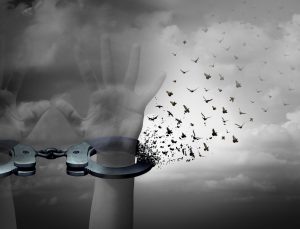Guilt is a necessary emotion. When anchored with a good conscience, it provokes truth and justice when wrong is committed. It prevents future wrong doing in some cases and helps guide the person to proper moral outcome. It is hence sometimes good to feel guilt. If one lacks guilt in appropriate circumstances, it is a sign of a deeper and more sinister moral flaw. Sociopaths are incapable of guilt and can commit the most grievous offenses without any sense of emotional wrong doing.

For the more tender hearted and as well as those who experience trauma, guilt can sometimes become excessive and over play its reach. It can become a pathological agent that prevents proper healing. When guilt is not properly processed and understood according to reality, it can then continue to haunt a person and prevent emotional healing. Guilt must be processed. If due to trauma it becomes part of dissociative material, then it can linger. It needs to find resolution, where appropriate sorrow is displayed and a chance for change and growth occur. When guilt is stunted, either not accepted or over felt, then it can keep a person stuck in the past.
With trauma, guilt is usually not proportionate and a variety of distortions exist. These distortions continue to exist when individuals keep trauma to themselves and do not face it. This is why dialogue is so critical to healing. It allows the wound to bleed and also the opportunity to discuss falsehoods regarding the traumatic event hence allowing integration of the memory.
Most distortions create an imbalance of guilt. Either the person blames oneself 100 percent or finds no blame at all. Associated with this are usually feelings that one does not deserve to live or survivor guilt. In addition, many individuals feel the guilt is critical to show they still care and that they must punish themselves and repeat the pain. Multiple reasons incur this guilt. Many believe they are guilty because they were afraid, or found relief. Others find guilt in having to kill, making a mistake, finding enjoyment in the event, wanting to die, or expressing extreme hatred. Others find guilt in their actions in not being able to save others, not taking precautions, freezing under pressure, not stopping the abuse, or not saying “I love you” one last time.
Many things can haunt a person who experienced trauma. Depending on the trauma and event, they can differ, but they all carry a haunting voice that judges what one felt, did not feel, did, or did not do. Distortions to the event can amplify the sorrow the person experiences.
Dialogue is obvious the first step in unlocking guilt. Various cognitive therapies look to identify guilt and then properly ascertain legitimacy of it. This involves discussing with a therapist the event itself and verbalizing the details. The patient then must attribute the level of what they think was their fault in a numerical percentage. Following this, the therapist challenges the events and asks probing questions of who else may be at fault. The guilt is then re-assessed and a recalculation occurs in which proportionate percentages of guilt are discovered to be less. This process can be repeated weekly to illustrate to the victim and patient that the guilt attributed is far from fair.
Also, the therapist can help the victim distinguish between the emotion of concern versus guilt, as well as shame and guilt. Many equate these emotions with guilt. The sexual victim may equate shame with guilt. In doing so, one can then start to attack the various distortions of guilt.
It is also important to help the patient understand their decision under pressure. Normal decision making under peaceful situations are quite different than decisions under duress. Fight or flight mechanisms can erupt and many lose rationality. So it is good to point out that one does not think the same way under trauma as if not. A therapist can also help the patient look at the choices that were available, the time constraints, all the information at the time and the intent of the outcome.
Another important way to help one see the past is to have the person play the role of two. As if an advisor or friend, to respond to one’s own criticism. By separating oneself from the event, and counseling one as if a friend, one can then begin to see the overall picture. So many therapists recommend patients play a two role therapy of talking and then responding as two different individuals.

In addition, various rituals can help. Spiritual visualization of healing, as well as finding forgiveness through a higher power.
Through this, one is better able to properly rank their guilt and true proportionate role in the traumatic event. The person can then understand the situation, move on from it and process it. Through this, the victim can be better prepared for the future and understand the role he or she played.
Of course, various therapies help individuals with PTSD and trauma better recollect the situation and process any negative emotions. EFT, Rewind Techniques, TIR and EMOR are all way therapists can better help an individual relate to the emotions and events of a particular trauma. They can also help the person cognitively restructure the event appropriately to reality. Removing inappropriate guilt is obviously an important step.
Please also review AIHCP’s Grief Counseling Program, as well as Stress Management Program and Crisis Intervention Program. All programs are helpful in teaching professionals to guide others through trauma. The programs are online and independent study and open to qualified professionals seeking a four year certification.
Sources:
“The Post Traumatic Stress Disorder Sourcebook: A Guide to Healing, Recovery and Growth” by Glenn Schiraldi, PhD
